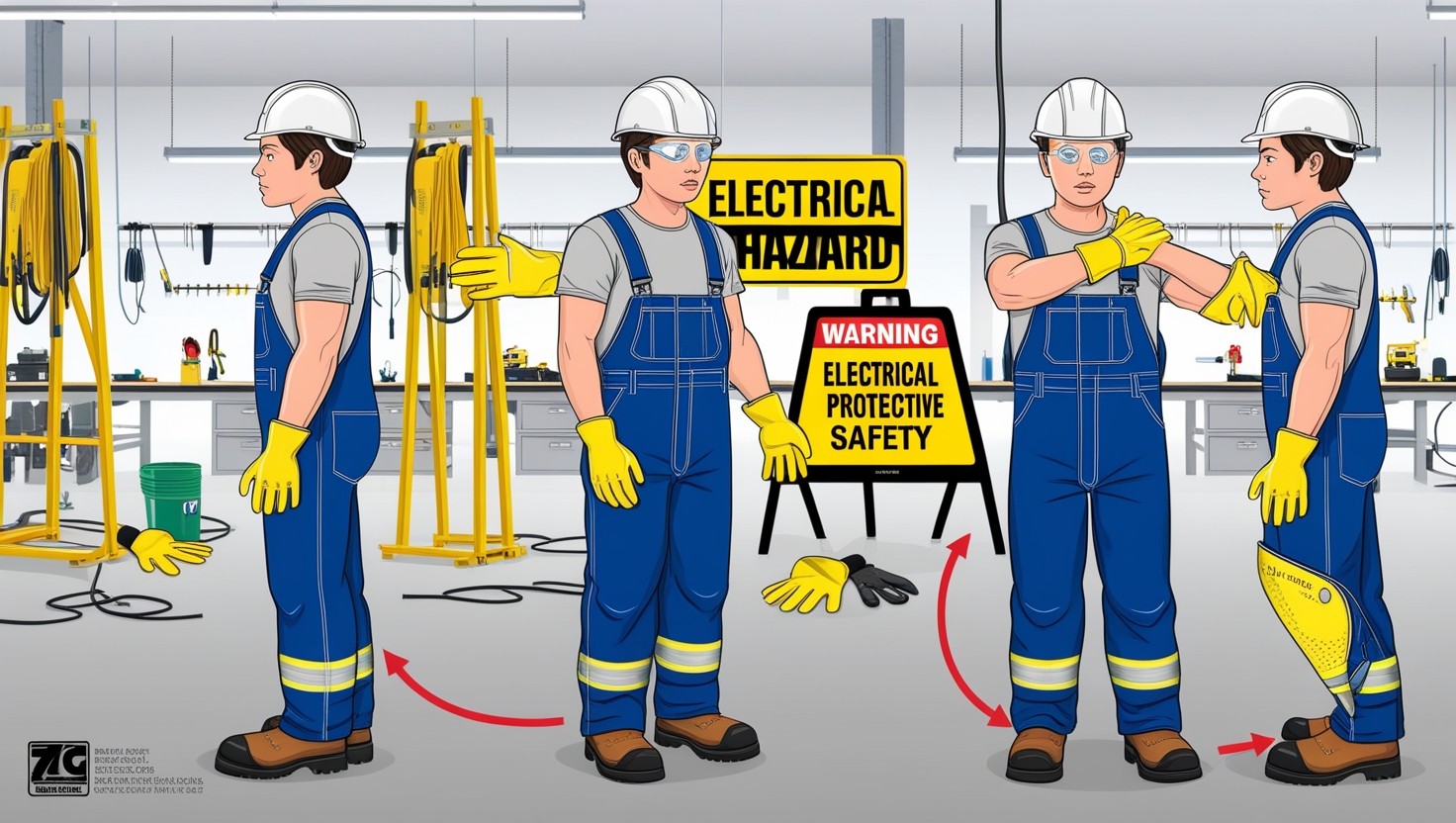Donning and Removing Personal Protective Equipment (PPE) for Electrical Safety
When working with electrical hazards, wearing the right personal protective equipment (PPE) is just the first step. Properly donning (putting on) and doffing (removing) PPE is equally important to ensure maximum protection and prevent accidental exposure. Incorrect handling can lead to electrical shocks, arc flash burns, or contact with hazardous materials.
This guide explains the correct procedures for safely donning and removing electrical safety PPE while minimizing risks.

Why Proper PPE Donning and Removal Matters
Electricians, maintenance workers, and engineers work in high-risk environments where electrical arcs, shocks, and burns are common hazards. PPE such as insulated gloves, arc-rated suits, and safety boots must be worn correctly to provide full protection.
Failing to follow proper procedures can result in:
- Reduced effectiveness of PPE due to poor fit or contamination.
- Increased risk of electrical contact if equipment is worn incorrectly.
- Cross-contamination when handling hazardous materials.
By following a structured method for donning and removing PPE, workers can ensure they remain safe throughout their tasks.
How to Don (Put On) Electrical PPE Correctly
Before starting any electrical work, PPE must be properly inspected and worn in the correct order.
Inspect PPE for Damage
Before donning, check each piece of PPE for:
- Visible damage such as tears, cracks, or burns.
- Signs of wear that may affect protection.
- Proper sizing to ensure a secure fit.
Wear Flame-Resistant (FR) Clothing
- Start with a base layer of flame-resistant garments. These should be free of synthetic materials, which can melt under extreme heat.
- Secure all fastenings, making sure no loose clothing is exposed.
Put On Insulated Gloves and Sleeves
- Inspect rubber-insulated gloves for punctures or tears before wearing.
- Use leather protector gloves over rubber gloves to prevent cuts or abrasions.
- If sleeves are required, tuck them under the glove cuffs for full coverage.
Secure Safety Boots
- Wear non-conductive, dielectric boots designed for electrical work.
- Ensure laces or fastenings are secured properly.
Wear a Hard Hat and Face Shield
- Use a non-conductive hard hat to protect from falling objects and arc flashes.
- Attach an arc-rated face shield or hood if working in areas with arc flash risks.
Use Insulated Tools
- Ensure all tools are voltage-rated and free from damage before use.
- Never substitute regular tools for insulated versions.
Once fully suited, conduct a final check before starting work to ensure everything is properly fitted.
How to Doff (Remove) Electrical PPE Safely
Removing PPE in the correct order is as important as putting it on. Improper removal can expose workers to residual hazards such as arc flash residue, contaminated gloves, or conductive materials.
Remove Insulated Gloves and Sleeves First
- Grasp the outside of one glove and peel it off without touching your skin.
- Use the inside-out technique to avoid contamination.
- Remove leather protectors separately to prevent damage to rubber gloves.
Take Off Face Shield and Hard Hat
- Lift the face shield away without touching the front to avoid contamination.
- Remove the hard hat by gripping the back strap, not the surface.
Step Out of Arc-Rated Clothing
- Unfasten the FR suit or jacket without shaking it to avoid spreading particles.
- Carefully fold it inside out and place it in a designated area for laundering.
Remove Safety Boots Last
- Untie and remove dielectric boots without touching the outside.
- Store them in a clean, dry area to maintain insulation.
Store or Dispose of PPE Properly
- Reusable PPE should be cleaned, inspected, and stored safely.
- Disposable PPE (such as single-use gloves) should be discarded in designated bins.
Once all PPE is removed, wash hands thoroughly to eliminate any residual contaminants.
Comparison: Proper vs. Improper PPE Donning and Removal
| Action | Proper PPE Handling | Improper PPE Handling |
|---|---|---|
| Glove Inspection | Check for holes, wear leather protectors | Wear gloves without inspection |
| Clothing Fit | Ensure full coverage with no exposed skin | Loose or untucked clothing |
| Tool Selection | Use voltage-rated, insulated tools | Use standard tools with no insulation |
| PPE Removal Order | Remove gloves first, then face shield, clothing | Remove randomly, increasing contamination |
| PPE Storage | Clean and store properly for reuse | Toss in any location, risking damage |
Best Practices for PPE Compliance
To ensure consistent and effective use of electrical PPE:
- Train workers regularly to understand the risks and correct procedures for donning and removing PPE.
- Conduct routine inspections before and after every shift.
- Use PPE that meets industry standards, including OSHA, NFPA 70E, and ASTM certifications.
- Replace worn-out gear, as damaged PPE offers little to no protection.
By following these best practices, workplaces can reduce electrical hazards and maintain a high level of safety.
Final Thoughts
Properly donning and removing electrical safety PPE is as important as wearing it. A small mistake, such as wearing gloves with holes or removing protective gear incorrectly, can lead to severe injuries or fatalities.
Electrical safety starts with knowledge, preparation, and strict adherence to safety protocols. Always follow the recommended procedures, inspect PPE before and after use, and prioritize protection every time you step onto the job.

